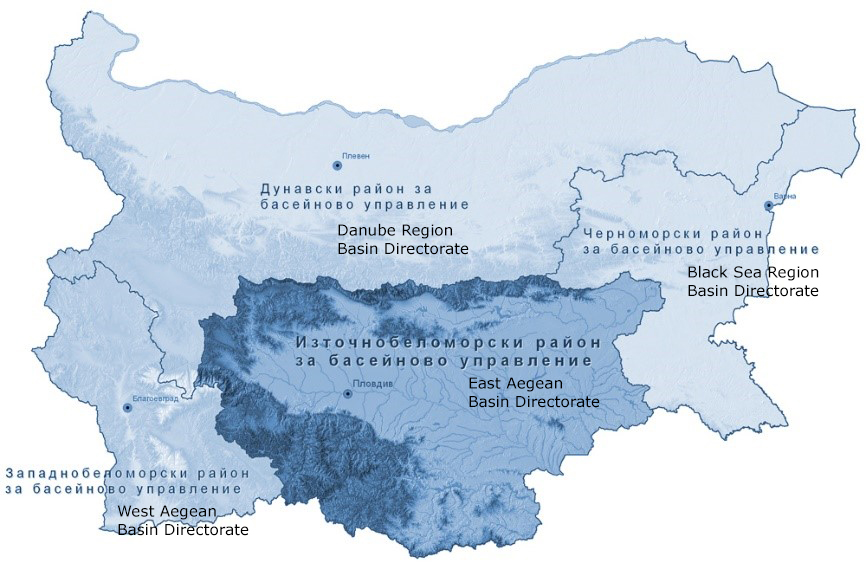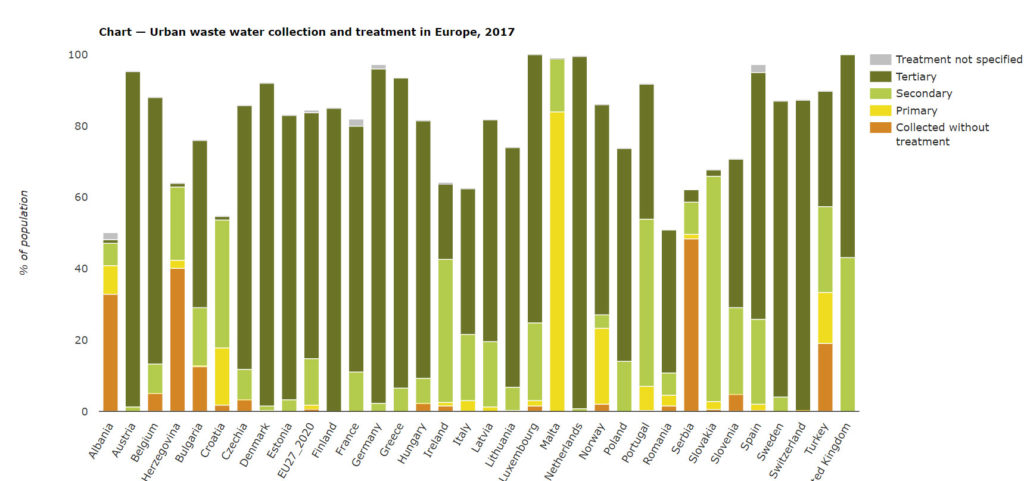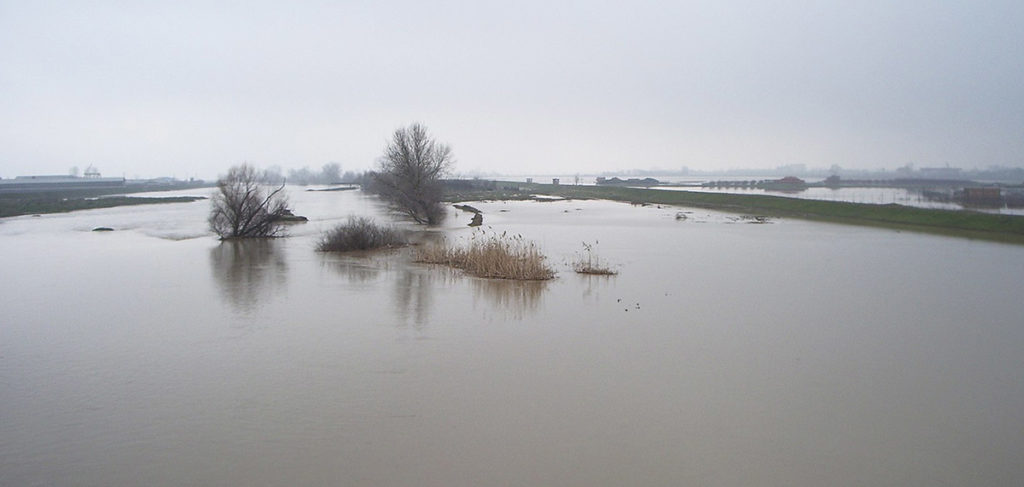Profile: Bulgarian water sector

-
 Editorial Team
Editorial Team
Share article:
Water News Europe is providing profiles of the water sector in different Member States. The Republic of Bulgaria has been an EU member country since 1 January 2007. The currency is the Bulgarian lev (BGN), however, the country is committed to adopting the euro (EUR) once it fulfils the necessary conditions. Part of these conditions is complying with European Directives, like the water directives.
Geography
The country borders Romania to the north, Serbia and North Macedonia to the west, Greece and Turkey to the south, and the Black Sea to the east. The climate is temperate in the North and Mediterranean in the South. There are mountains and hills with lowlands in the North and Southeast. In winter the Balkan Mountains can be snow-capped.

The country has a dense river network but most rivers are short and have a low water flow. The largest and longest river is the Danube. The average annual precipitation is 670 mm; the rainfall is lower in the lowlands and higher in the mountains. The driest region is Dobrudzha in the north-eastern part of the Danubian Plain, while the highest rainfall normally falls in the upper valley of the river Ogosta in the western Balkan Mountains.

Water Stress in Bulgaria
Bulgaria has over 400 lakes and 64 rivers and a coastline of 378 km along the Black Sea. In recent years the country has been experiencing a shortage of water resources. According to the World Resources Institute (2019) a large part of the territory is under extreme levels of water stress.
Bulgarian water and wastewater
The Bulgarian water sector has 64 water and sanitation service providers, of which 56 are state owned. The 29 regional water companies provide services to 76% of the population with the rest of the service providers serving single municipalities. Fourteen multicity utilities are state-owned water companies. They cover the largest area of the country and they are managed by the Ministry of Regional Development. The other utilities are owned by municipalities. The number of wastewater treatment plants is 89.
Ministry of Environment and Water
The Ministry of Environment and Water (MoEW) defines national policies, develops strategies, prepares standards and sets priorities for environmental protection. Its focus is on achieving and maintaining the good status of all groundwater, surface and sea water. The Ministry works with a Water Management Directorate and at the basin level with four Basin Directorates, and with 15 Regional Inspectorates of Environment and Water, monitoring the control of wastewater within their respective territorial scope.
The River Basin Directorates and the River Basin Management Plan (RBMP) include measures that can help restore ‘good ecological status’ of the water bodies through treatment, construction of treatment facilities, removal of unnecessary thresholds from riverbeds and others.

Danube Region Basin Directorate
The Danube Basin management region with its centre in Pleven includes the catchment areas of the Iskar, Erma, Nishava, Ogosta and west of Ogosta, Vit, Osam, Yantra, Rusenski Lom and Danube Dobrudzha rivers. As an administrative-territorial scope, the activity of the Directorate covers 18 districts (including Sofia, Pleven, Lovech, Ruse, Silistra, Veliko Tarnovo, Vratsa, Montana, Vidin, Razgrad, Dobrich, and Shumen) and 126 municipalities, a total area of 47,235 sq. km, or 42.5% of the country’s territory.
The Directorate performs managerial, regulatory, informational and control functions. In performing these functions, it conducts and participates in activities related to the state policy in the field of water management. These include:
- The development of the River Basin Management Plan and the Flood Risk Management Plan, the management of the waters of state property and the management of all groundwater facilities, which are public state property.
- The permit regime for water abstraction and use of water bodies shall be introduced by the Water Act as a means of regulating people’s water resource needs in terms of quantity and quality. In addition, the regulatory functions include the development of water monitoring networks at the basin level, the definition of sanitary protection zones around drinking water supply facilities, and the keeping of registers of issued permits.
- Providing information to the public on the state of water, media relations in general and with the population in the basin management area, contact with all stakeholders, as well as the involvement of citizens in the management and decision-making process.
- The prevention of the consequences of any harmful impact on water systems and supplies. The preservation and protection of the aquatic ecosystems and related ecosystems predetermine the control functions of the Basin Directorate.
East Aegean Basin Directorate
The East Aegean region is located in the central southern part of the territory of the Republic of Bulgaria. It covers the catchments of the Maritsa, Tundzha and Arda rivers. All three rivers are transboundary, with the Arda and Tundzha being part of the international river basin of the Maritsa which flows into the Aegean Sea. Hence, parts of its river basin are located on the territories of Greece and Turkey.
The main functions of the East Aegean Basin Directorate vary from control of the activities performed in the river beds; control of the condition and operation of water intake facilities, surface and groundwater facilities and measuring equipment water quantities; control of the fulfilment of the conditions of permits, with the exception of those for use by a water body for wastewater discharge; control of the quantity and quality of water; control of the maintenance of the minimum allowable outflow into rivers; control of water monitoring; control of the fulfilment of the legal obligations for payment of fees.
West Aegean Basin Directorate
The West Aegean Region covers the Struma, Dospat, and Mesta rivers. The Struma originates from the springs among the magmatic rocks of the Vitosha Dome, the highest of which, is Cherni Vrah (2290 m). The Mesta is formed by the confluence of the Byala and Cherna Mesta rivers above the town of Yakoruda. Its initial tributaries spring from the highest eastern (Musalenski) part of the Rila Mountains. The Dospat springs up from below the Rozov peak (1643 m) in the Velijsko-Videnishki part of the Western Rhodopes.
Black Sea Region Basin Directorate
The Black Sea Basin Management Region covers the catchment areas of the rivers flowing into the Black Sea from the northern to the southern border of Bulgaria, including inland waters and the territorial sea, which represents approximately 14.7% of the country’s territory (45 municipalities in eight districts – Dobrich, Varna, Shumen, Targovishte, Razgrad, Burgas, Sliven and Yambol). The territorial sea, a 12-mile zone along the 378-kilometre (km) border has an area of 6,360 square km. The adjacent zone, a 24-mile zone, is the sea strip that extends from the coastline to the territorial sea at a distance of 24 nautical miles from the baselines from which the breadth of the territorial sea is measured.
The Directorate performs planning, control, information functions, as well as water management of state property. Its objectives are the prevention of deterioration, the protection and improvement of the state of aquatic ecosystems, terrestrial ecosystems and wetlands directly dependent on them; promoting the sustainable use of water through long-term conservation of available water resources; complex, multiple and efficient use of water resources; implementation of measures for protection and improvement of the aquatic environment; continuous reduction of groundwater pollution and prevention of pollution; reducing the effects of floods and droughts; and flood risk assessment and management.
Regional inspections
There are sixteen Regional Inspectorates of Environment and Water (RIEW) in Bulgaria. They are located in Blagoevgrad, Burgas, Varna, Vratsa, Veliko Tarnovo, Montana, Pazardzhik, Pleven, Plovdiv, Ruse, Smolyan, Sofia, Stara Zagora, Haskovo and Shumen.
The regional inspectorates are administrative structures of the Ministry, ensuring the implementation of the state policy on environmental protection at the regional level. They operate in one or more areas, having regulatory, informational and control functions. In carrying out the regulatory functions, they develop or participate in the development of documents in the field of environmental protection and sustainable use of natural resources and conduct activities at the regional level related to state policy.
The control functions of the RIEW consist of the implementation of preventive, current and subsequent control over the application of normative acts, regulating the quality of the components of the environment and the factors that affect it. The control activities are related to prevention of pollution or damage, restoration of the environment from pollution or damage, protection of water from pollution, compliance with the requirements for ensuring environmentally friendly waste management, protection of the elements of the National Ecological Network and biodiversity, and quality protection of atmospheric air.
RIEWs carry out inspections, draw up warning and ascertainment protocols, give prescriptions, control their implementation, request references, documents and written explanations from the representatives of the inspected sites; draw up acts for establishing administrative violations; provide access to sites for inspection when the activities in them are current or potential sources of pollution or damage to the environment; request and receive assistance from state and municipal authorities, organisations, legal entities and individuals; participate and assist in the establishment and operation of the National Environmental Monitoring System; impose coercive administrative measures.
Other institutions that are part of the Bulgarian water sector are:
- The Ministry of Agriculture, Food and Forestry (MAFF). This is the main consumer of water resources, and through the Ministry’s irrigation systems maintains and operates the state hydro-ameliorative fund for water management for irrigation of agricultural crops. It is also responsible for various drainage and protection facilities, such as dikes, retention dams and drainage fields. The other structures of the MAFF that have certain related powers are: the Executive Agency for Fisheries and Aquaculture, the Executive Agency for Forests, as well as the directorates of nature parks.
- The Ministry of Regional Development and Public Works (MRDPW) has powers through the Directorate for the National Construction Control when it comes to construction within the scope of a water body.
- The Ministry of Energy can take action related to the country’s energy security through the National Energy Company (NEK) and their Dam and Cascades branch.
- The last ministry concerned with water issues is the Ministry of the Interior (MoI) and, in particular, the Directorate General for Fire Safety and Protection of the Population, which is responsible for civil protection in the event of floods and related emergencies.
Drinking water production
In Bulgaria public companies are responsible for drinking water. Consumers receive water treated in a drinking water treatment plant. These facilities are part of the Bulgarian Water and Sewerage Holding EAD. This is a sole proprietorship holding company with state property in the capital and is the principal of all companies with state participation in water supply and sewerage. Its main goal is the long-term provision of a sustainable model for financing the water supply and sewerage sector and related strategic goals, guaranteeing quality water supply and sewerage services while ensuring an affordable price of these public services to consumers. Veolia which is part of the project Sofia Water established in October 2000 under a 25-year Concession Agreement. This company is operating and maintaining the water supply and sewerage system in Sofia. The share capital is distributed between Sofia Municipality (22.9%) and Veolia (77.1% of the shares). The water supply and sewerage assets are public municipal property and all new facilities built with company funds are municipal property.
Water infrastructure
The water supply network in Bulgaria is in a difficult state – for the most part it is from the 1960s and 70s, and the annual percentage of loss is progressively increasing. According to the Drinking Water Directive water leakages have to be reduced.
Bulgarian water sector organisations
The Bulgarian Water Association is a non-profit organisation that was established in 2005 in Sofia. It includes legal and natural persons with interests related to water supply and sewerage, including the quality and treatment of drinking, industrial, agricultural and domestic wastewater; management, conservation and use of water resources. Legal entities are collective members and include regional and local commercial companies and water and sewerage, design, construction, production, export, import and other companies.
Union of Water and Sewerage Operators in the Republic of Bulgaria is a voluntary non-profit association of which 49 water and sewerage operators from the Republic of Bulgaria are members. Its main goals are to support and implement government policy regarding water supply and sewerage companies, namely – water supply, sewerage, drinking and wastewater treatment – and to represent operating companies before government agencies, to participate in the negotiations with employees of representative organisations in the councils for tripartite cooperation.
Bulgarian Water Companies
Water companies funded in Bulagria are Hydro-Hicks-Bulgaria (specialized in import, delivery, chief installation, full engineering and consulting, service and training in the field of water treatment for the energy sector and industry) and Hydrolia. The last mentioned company provides industrial companies with drinking water.
Jobs and education
According to the latest statistics (2017) the number of people working in the Bulgarian water sector is 32.327. Practical education and courses are available through the Bulgarian Water Association:
Applied hydrobiology and aquaculture at Sofia University St. Kliment Ohridski
Water legislation
The Bulgarian Water Act regulates the ownership and management of waters and the ownership of water development systems and facilities. Its objectives are to create conditions for: integrated management of water; supply of good quality surface and groundwater; reduction of pollution of waters; protection of surface waters and groundwater and waters of the Black Sea; elimination of pollution of the marine environment with natural or synthetic substances; reduction of discharges, emissions and loss of priority and hazardous substances.
Bulgaria and Bathing water quality
According to the Bathing Water Directive report from 2021, the bathing water quality has changed slightly. The percentage of ‘excellent’ has been fluctuating for the period 2017-2020. The percentage of ‘good’ levels has mainly dropped for the same period. ‘Sufficient’ has decreased completely (from 6 to 0). Poor has improved (from 1 to 0). As far as any specific climate changes, the report does not mention those.
Bulgaria and the Urban Waste Water Treatment Directive
The EU Urban Waste Water Treatment Directive (UWWTD) sets out a time plan for the construction of infrastructure for collecting and treating waste water in urban areas. In general, waste water must be subject to biological treatment (secondary treatment), which removes a very high proportion of organic pollution, bacteria and viruses. To reduce the risk of algal blooms, further removal of nitrogen and/or phosphorus is required in larger urban areas that are connected to sensitive water bodies.
According to statistics of the European Environment Agency for 2017, 47% of the water in Bulgaria has been under tertiary treatment, mainly to reduce nutrients. However, more than 12% of the water that has been collected from sewerage has not been treated before discharge. In 2018, Bulgaria had 332 urban waste water agglomerations of more than 2.000 population equivalent (p.e.). These generated a total load of 7 060 902 p.e., 90% of this is connected to collecting systems and 5% addressed through individual and appropriate systems (storage or septic tanks, micro-stations). These agglomerations are connected to one primary treatment plant, seven secondary treatment plants and 104 more stringent treatment plants. All these treatment plants have a total design capacity of 8 582 178 p.e.
Access to sanitation services is still low and Bulgaria demonstrates low compliance rates with the UWWTD (European Commission (EC), 2017). Only 66% of the population is connected to a wastewater collection network, and just 50% to a wastewater treatment plant. Access to sanitation services is a problem for vulnerable populations. For example, the access rate for flush toilets is 50% for the bottom 40% of the population (World Bank, 2015). Much of the water and sanitation infrastructure in Bulgaria needs improvement or extension as most of it was built in the 1960s and 1970s, and is in need of repair (WB, 2015b). Bulgaria has a higher level of nonrevenue water than most European countries, which is attributed to physical water loss from aging infrastructure as well as inefficient utility operation (WB 2015b). Water losses, both technical and commercial, are up to 80% for some operators (EurEau, 2017).

Bulgaria and the Floods Directive
In 2020 there were 100 floods reported in the whole country. The EC reminded Bulgaria in February 2022 in an official letter to provide updated flood risk maps. Aid granted from the EU Solidarity fund for flood damages was EUR 10.5 million in 2014 and EUR 6.3 million in 2015 (EC, 2017).

There is a growing awareness of the need for ex-ante protection against disaster risks and a number of institutions and policies now deal with emergency response and preparedness. Bulgaria has taken steps toward preparation of a national climate change adaptation strategy, including a vulnerability assessment of sectors most at risk (WB, 2015).

Bulgaria is adopting strategies for releasing more room for the Danube river. The Lower Danube comprises about 860 km of the 2,800-km long river, downstream of the Iron Gates Dams through the Danube Delta, before it flows into the Black Sea. Conversion of floodplains for farming and other development has seen 95% of the upper Danube, 75% of the lower Danube and 28% of the delta’s floodplains cut off by dikes. This has exacerbated flood peaks, and climate change is expected to increase the frequency of floods and droughts. Bulgaria, in the recent years, has included the adoption of new laws and instructions, strengthening the role of the integrated rescue system, and operational communication – information centres in the territories of each region are under construction.
Bulgaria and the Water Framework Directive
There has been a gradual improvement in the quality of surface and ground water during the last decade. However, there are still many water bodies at risk and diffuse pollution affects almost half of surface water bodies. There are significant differences between water basin districts. Diffuse sources are the major pressure in the Black Sea district, whereas water abstraction is the major pressure in the West Aegean district. In the Danube district, all pressures affect a high proportion of water bodies. The current River Basin Management Plans have significant gaps. Therefore uncertainty remains about the effectiveness of proposed measures. In addition, navigation and related activities, such as port development or dredging, have not been considered in the plans as pressures.

Bulgaria and the Nitrates Directive
Overall, the quality of national action programmes has improved, but in many cases the measures in place are not sufficiently effective in fighting pollution in areas where agricultural pressure has increased. According to the EC, the Bulgarian authorities have failed to fully align their national anti-nitrate action plan with EU rules, particularly on the spreading of fertiliser and the annual cap of 170 kg N/ha for livestock farming effluents.
Bulgaria and the Drinking Water Directive?
Since Bulgaria became a EU-Member the access to drinking water has improved, but there are still places where the water does not comply to the standards of the Drinking Water Directive. More investments are necessary to improve the quality of drinking water.













